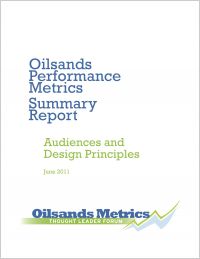On May 3, 2011, the Pembina Institute, the Institute for Sustainable Energy, Environment and Economy and Deloitte hosted a Thought Leader Forum on oilsands performance metrics. Almost 60 participants, representing government, industry, academia, non-governmental organizations and a number of other groups, discussed two main topics:
 Audience for Metrics: Who are the various audiences for oilsands performance metrics? How will different audiences use the metrics?
Audience for Metrics: Who are the various audiences for oilsands performance metrics? How will different audiences use the metrics?
Principles for Metrics: What guiding principles should metric developers use? How would we recognize if those principles were being met?
Interviews with eight thought leaders:
- Clive Mather, former CEO of Shell Canada
- Jamie Bonham, NEI Investments
- Barry Worbets, Canada West Foundation
- Jennifer Grant, The Pembina Institute
- Peter MacConnachie, Suncor Energy
- Brad Stelfox, ALCES Group
- Chris Powter, Oil Sands Research and Information Network
- Kim Sturgess, WaterSmart
Clive Mather, former CEO Shell Canada
First up is Clive Mather, the keynote speaker at the event. He says it's important for the varied stakeholder groups to get together and come up with the guiding principles under which oilsands development takes place. He would like to see measurable standards created to help industry perform better and government regulate better because "we frankly need to do things better and metrics is a key way of ensuring that happens."
Jamie Bonham, NEI Investments
Bonham is a senior analyst with NEI Investments and he says oilsands metrics are needed to ensure the environmental and social impacts do not outweigh the economic benefits of the oilsands. He says the investment community is increasingly engaging companies on matters of sustainability and that good metrics are critical to help investors make good decisions.
Barry Worbets, Canada West Foundation
Worbets says metrics are an absolutely, "fundamental piece of a system that's required to allow ourselves, with a clear conscience, to develop an oilsands resource in a sustainable way."
Jennifer Grant, Pembina Institute
Grant is the oilsands director of the Pembina Institute. She says metrics are a critical source of information to benchmark and assess company performance. She cites the Institute's in situ report card that looked at the environmental performance of nine different companies. Some of the information that came out of that work showed clear room for improvement. "We want to ensure oilsands development proceeds within the limits of air, land and water systems."
Peter MacConnachie, Suncor Energy
MacConnachie, the senior sustainability issues management specialist with Suncor, says the public has a poor understanding of oilsands and that metrics can help. With so much debate about the meaning of the facts surrounding oilsands development, MacConnachie says oilsands metrics will only mean something to people if they are involved in the process of creating them. "It can't be a bunch of industry folks sitting in a room and nor can it be a bunch of environmentalists sitting in a room."
Brad Stelfox, ALCES Group
Stelfox is an ecologist who says the GDP is not the only important tool for measuring the benefits and impacts of the oilsands; we need to understand and measure ecological goods and services, too. Stelfox was there with other folks from a variety of sectors to attempt to find some common principles under which a series of oilsands metrics could be developed.
Chris Powter, Oil Sands Research and Information Network
Chris Powter is the executive director of the Oil Sands Research and Information Network at the University of Alberta. Powter says he thinks people are confused about the current state of affairs in the oilsands and what is needed to make it sustainable. "A set of metrics that everyone can understand and can be communicated openly would help people get a better sense of whether oilsands development is in the public interest or not."
Kim Sturgess, WaterSmart
Sturgess points to finances as the "sleeper" issue of oilsands metrics. "It's the financial community and the insurance community who are now looking at the oilsands and risks associated with it," says Sturgess. These industries are already using some metrics to decide what form of energy or which company to invest in.
